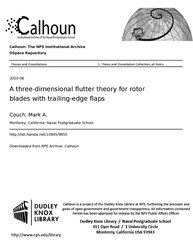File:A three-dimensional flutter theory for rotor blades with trailing-edge flaps (IA athreedimensiona109459855).pdf

Original file (1,275 × 1,650 pixels, file size: 5.34 MB, MIME type: application/pdf, 238 pages)
Captions
Captions
Summary[edit]
| A three-dimensional flutter theory for rotor blades with trailing-edge flaps
( |
||
|---|---|---|
| Author |
Couch, Mark A. |
|
| Title |
A three-dimensional flutter theory for rotor blades with trailing-edge flaps |
|
| Publisher |
Monterey, California. Naval Postgraduate School |
|
| Description |
This dissertation develops the equations of motion for the structural and aerodynamic forces and moments of a rotor blade with a trailing-edge flap using eight degrees of freedom. Lagrange's equation is applied using normal modes to find the flutter frequency and speed similar to the classic fixed-wing method developed by Smilg and Wasserman. However, rotary-wing concerns are addressed including different freestream velocities along the blade (variation of reduced frequency along the span of the rotor blade) and the influence of previously shed vortices on the aerodynamic forces and moments (Loewy's returning wake). While Loewy [Ref. 49] did not explicitly state that his 2-D theory would apply to rotor blades with trailing-edge flaps, the manner in which the theory was developed allows it to be applied in this manner. Comparisons to classic 1DOF, 2DOF and 3DOF flutter theories are made to validate this theory in the limiting cases. Flutter analyses, including g-. plots, of an example rotor blade with five degrees of freedom are performed for various rigid body flap frequencies. Classic methods of rotor blade design of ensuring freedom from flutter are to collocate the center of gravity (c.g.), elastic axis (e.a.), and aerodynamic center (a.c) at the 25% chord. With the development of rotor blades with trailing-edge flaps, it is shown that this current design practice is not valid when a trailing-edge flap is incorporated. Subjects: Unsteady flow (Aerodynamics); Flutter; Rotary Wing; Aeroelasticity. Trailing-edge Flaps; Unsteady Aerodynamics; Structural Dynamics; Holzer Method; Myklestad-Prohl Method; Rotor Blades; Vibrations; |
|
| Language | English | |
| Publication date | June 2003 | |
| Current location |
IA Collections: navalpostgraduateschoollibrary; fedlink |
|
| Accession number |
athreedimensiona109459855 |
|
| Source | ||
| Permission (Reusing this file) |
This publication is a work of the U.S. Government as defined in Title 17, United States Code, Section 101. As such, it is in the public domain, and under the provisions of Title 17, United States Code, Section 105, may not be copyrighted. | |
Licensing[edit]
| Public domainPublic domainfalsefalse |
This file is a work of a sailor or employee of the U.S. Navy, taken or made as part of that person's official duties. As a work of the U.S. federal government, it is in the public domain in the United States.
|
 | |
| This file has been identified as being free of known restrictions under copyright law, including all related and neighboring rights. | ||
https://creativecommons.org/publicdomain/mark/1.0/PDMCreative Commons Public Domain Mark 1.0falsefalse
File history
Click on a date/time to view the file as it appeared at that time.
| Date/Time | Thumbnail | Dimensions | User | Comment | |
|---|---|---|---|---|---|
| current | 21:29, 14 July 2020 |  | 1,275 × 1,650, 238 pages (5.34 MB) | Fæ (talk | contribs) | FEDLINK - United States Federal Collection athreedimensiona109459855 (User talk:Fæ/IA books#Fork8) (batch 1993-2020 #8649) |
You cannot overwrite this file.
File usage on Commons
The following page uses this file:
Metadata
This file contains additional information such as Exif metadata which may have been added by the digital camera, scanner, or software program used to create or digitize it. If the file has been modified from its original state, some details such as the timestamp may not fully reflect those of the original file. The timestamp is only as accurate as the clock in the camera, and it may be completely wrong.
| Short title | A three-dimensional flutter theory for rotor blades with trailing-edge flaps |
|---|---|
| Author | Couch, Mark A. |
| Software used | Couch, Mark A. |
| Conversion program | Acrobat Distiller 5.0.5 (Windows) |
| Encrypted | no |
| Page size | 612 x 792 pts (letter) |
| Version of PDF format | 1.4 |

